TW164B
TW164B 1-to-4 Port Smart Power GNSS Signal Splitter
The Calian TW164B is a professional-grade full GNSS band signal splitter that connects one antenna up to four receivers, and supports GPS/QZSS-L1/L2/L5, QZSS-L6, GLONASS-G1/G2/G3, BeiDou-B1/B2/B2a/B3, Galileo-E1/E5a/E5b/E6, NavIC-L5, and L-Band correction services. This model has all four receiver ports in-line on the backside of the splitter, with the antenna port located on the frontside.
GNSS has become a critical component in safety, security, timing, and infrastructure applications, all of which require very high availability. As a result, resilient fault-tolerant components are essential to avoid service interruptions.
The design of first-generation GNSS signal splitters suffered from a single point of failure: only one attached receiver powered the splitter and the antenna. If this receiver failed or was unplugged, all attached receivers also failed.
Calian’s current-generation TW164B Smart Power GNSS signal splitter provides two additional key features:
First, it accepts power from all attached GNSS receivers and selects power from a receiver using the following protocol. Port #1 is given priority if its voltage is within the specified range (3.3 – 12.5 VDC). However, if port #1’s receiver is disconnected or if its receiver power goes below the under-voltage or above the over-voltage specification, the TW164B will switch to the next port in numerical order, as long as its power and voltage are within the expected range. The switching and port selection is, therefore, deterministic.
Second, if the antenna fails and does not draw current, the TW164B will provide all connectors with a current draw lower than 1 mA, indicating an antenna fault.
The TW164B offers the best in-class performance in terms of noise figure, isolation, and linearity. In addition, it is packaged in a robust, compact, lightweight, and waterproof (IP67) corrosion-protected aluminum housing.
The TW164B is available with either SMA Female, N-Type or TNC connectors and offers standard gain to compensate for signal-splitting loss.
It is recommended that unused ports should be terminated with a 50 Ohm load.
Applications
- GNSS signal distribution
- GNSS receiver testing
- High-availability applications
- Network and infrastructure timing
Features
- Accepts power from all attached receivers
- Automatic switching on failure of a receiver
- Antenna failure detection/indication
- Rugged military-grade aluminum enclosure
- Amplified to compensate for splitting loss
- Very low noise figure
- IP67 compliant
Benefits
- Allows up-to 4 receivers to share one antenna
- Fits in-line with antenna cable
- Robust package
- Ideal for harsh environments
TW165B
TW165B1-to-4 Port Smart Power GNSS Signal Splitter (10 dB gain)
The Calian TW165B is a professional-grade full GNSS band signal splitter that connects one antenna up to four receivers, and supports GPS/QZSS-L1/L2/L5, QZSS-L6, GLONASS-G1/G2/G3, BeiDou-B1/B2/B2a/B3, Galileo-E1/E5a/E5b/E6, NavIC-L5, and L-Band correction services. This model has all four receiver ports in-line on the backside of the splitter, with the antenna port located on the frontside.
GNSS has become a critical component in safety, security, timing, and infrastructure applications, all of which require very high availability. As a result, resilient fault-tolerant components are essential to avoid service interruptions.
The design of first-generation GNSS signal splitters suffered from a single point of failure: only one attached receiver powered the splitter and the antenna. If this receiver failed or was unplugged, all attached receivers also failed.
Calian’s current-generation TW165B Smart Power GNSS signal splitter provides two additional key features:
First, it accepts power from all attached GNSS receivers and selects power from a receiver using the following protocol. Port #1 is given priority if its voltage is within the specified range (3.3 – 12.5 VDC). However, if port #1’s receiver is disconnected or if its receiver power goes below the under-voltage or above the over-voltage specification, the TW165B will switch to the next port in numerical order, as long as its power and voltage are within the expected range. The switching and port selection is, therefore, deterministic.
Second, if the antenna fails and does not draw current, the TW165B will provide all connectors with a current draw lower than 1 mA, indicating an antenna fault.
The TW165B offers the best in-class performance in terms of noise figure, isolation, and linearity. In addition, it is packaged in a robust, compact, lightweight, and waterproof (IP67) corrosion-protected aluminum housing.
The TW165B is available with SMA, TNC, or type-N connectors and offers 10 dB gain over the splitting-loss.
It is recommended that unused ports should be terminated with a 50 Ohm load.
Applications
- GNSS signal distribution
- GNSS receiver testing
- High-availability applications
- Network and infrastructure timing
Features
- Accepts power from all attached receivers
- Automatic switching on failure of a receiver
- Antenna failure detection/indication
- Rugged military-grade aluminum enclosure
- Amplified to compensate for splitting loss
- Very low noise figure
- IP67 compliant
Benefits
- Allows up-to 4 receivers to share one antenna
- Fits in-line with antenna cable
- Robust package
- Ideal for harsh environments
HCS885XF Smart GNSS Helical SDK
Calian’s HCS885XF L1/L5 Smart GNSS Precise Heading Helical Antenna is the plug-and-play, lightweight, low-power L1/L5 solution for Precise Heading* for Robotics and Drones.
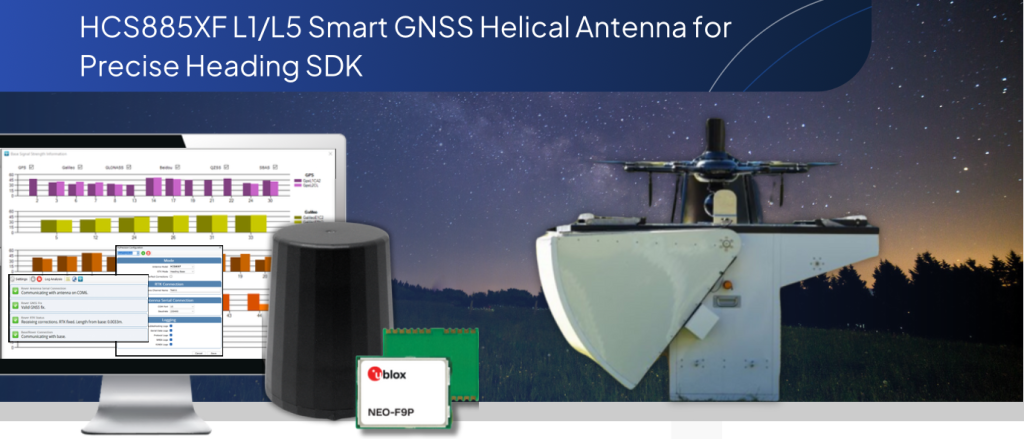
Calian’s HCS885XF Smart GNSS Helical Antenna is the Plug and Play, light weight, low power L1/L5 solution for Handheld Devices, Robotics and Drones, utilizing the L5 enhanced signal architecture with stronger broadcast signal to offer more precise standard localization and improved multi-path mitigation while operating in an ITU/ARNS aviation band with regulatory interference protection.
* Two HCS885XF Smart GNSS Helical Antennas and therefore 2 SDK’s are required for Precise Heading Functionality
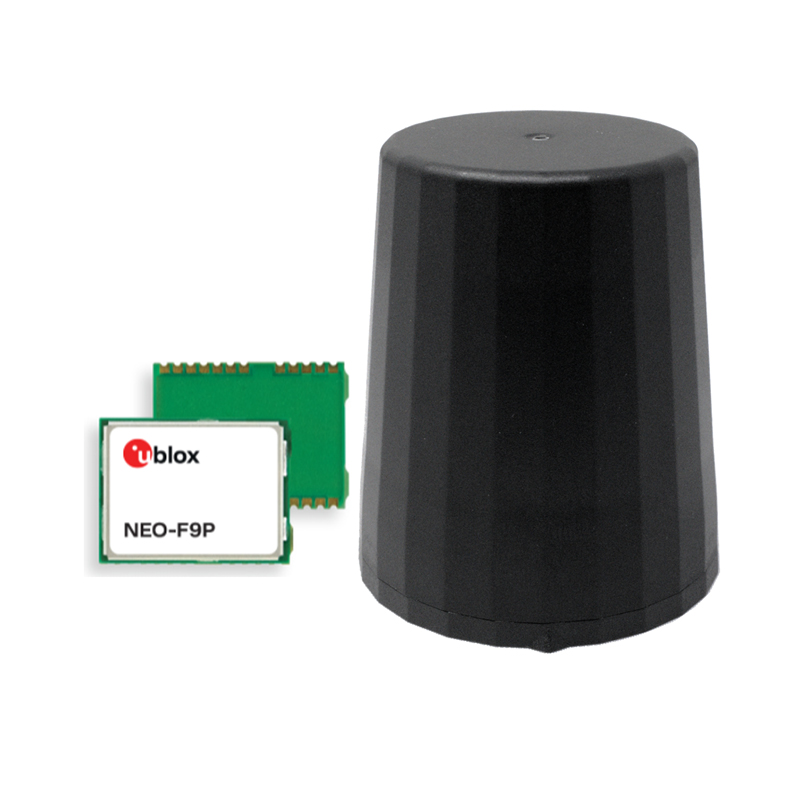
HCS885XF Smart GNSS Antenna
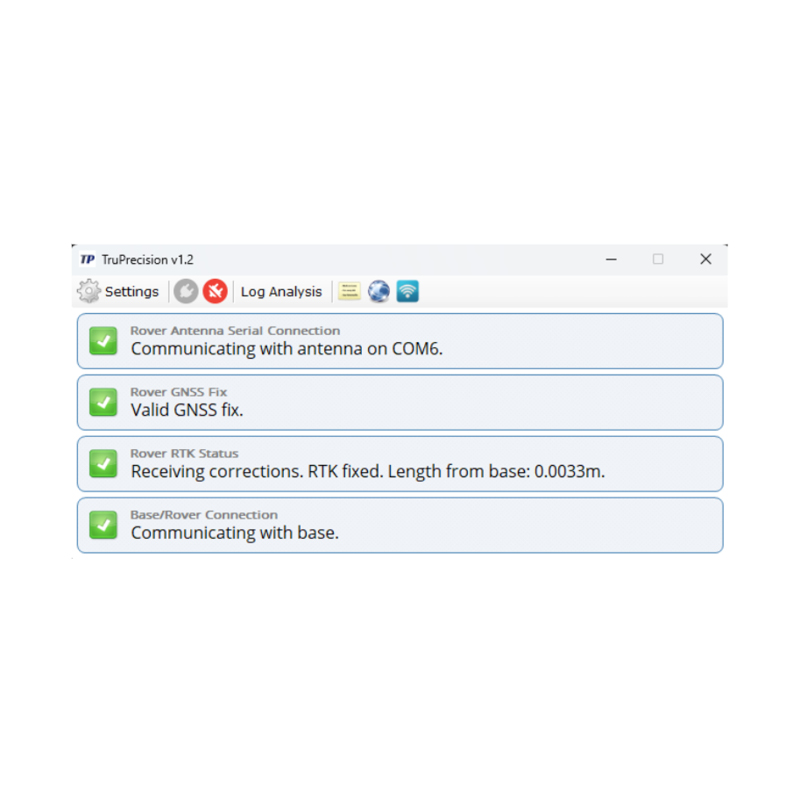
TruPrecision Software

60 Days Complimentary Corrections Trials
The HCS885XF SDK supports the HCS885XF L1/L5 Smart GNSS Helical Antenna. The HCS885XF incorporates the u-Blox NEO-F9P GNSS receiver. It features:
- MQTT client for PointPerfect Flex PPP-RTK Corrections over L-Band or terrestrial network ( sub 6 cm accuracy)
- NTRIP client for RTK Base/Rover Configurations (cm-level accuracy)
- NMEA monitoring, satellite visibility and signal strength, GNSS status monitoring and logging tools, with visual state heat-map and message routing for sharing RTCM between base/rover pairs across the internet
- Status console to pinpoint issues between antenna, connections and network corrections
- Complimentary access to:
- ublox’ PointPerfect Flex GNSS Augmentation Service (60 days),
- Swift Navigation Skylark Cx Precise Positioning Service (6 months) and
- Point One Navigation Polaris RTX (1 year free service).
- ROS2® drivers also available.
HCS885XFSDK Precise Heading SDK includes:
- 1 x Calian HCS885XF Smart GNSS Precise Heading helical antenna
- 33-HCS885XF-29 (RS-232 ) or 33-HCS885XF-49 (CMOS)
- Calian TruPrecision Application for Software Development and Verification
- Complimentary Trial subscriptions to:
- u-blox PointPerfect Flex PPP-RTK (60 days);
- Swift Navigation Skylark Cx Precise Positioning Service (6 months);
- Point One Navigation Polaris RTK Corrections Service (1 year free service)
- 1 x JST to USB cable
Ordering Information:
- w33-HCS885XFSDK-4 (CMOS to USB Cable)
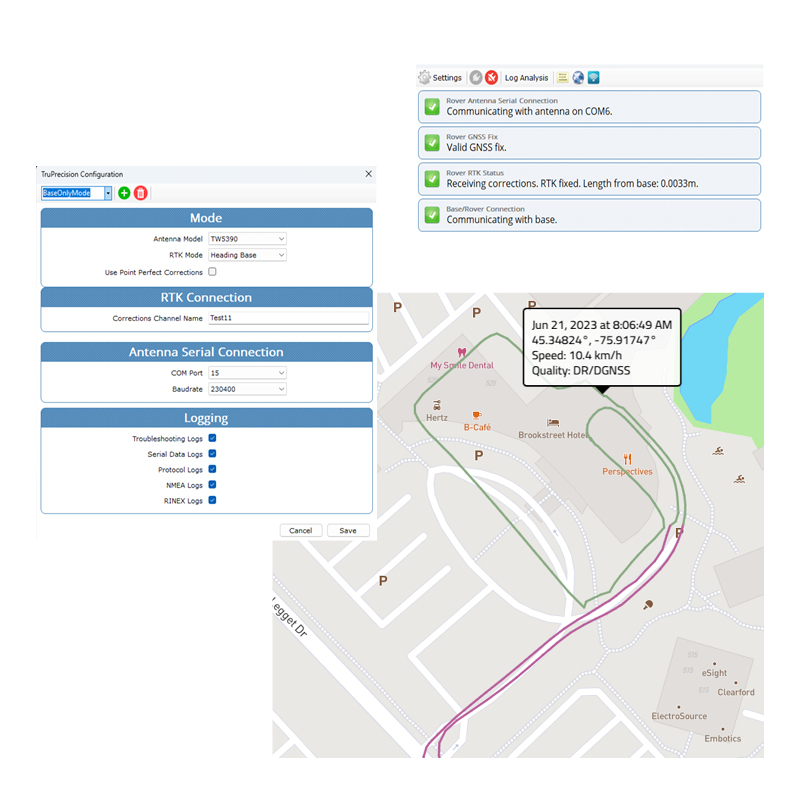
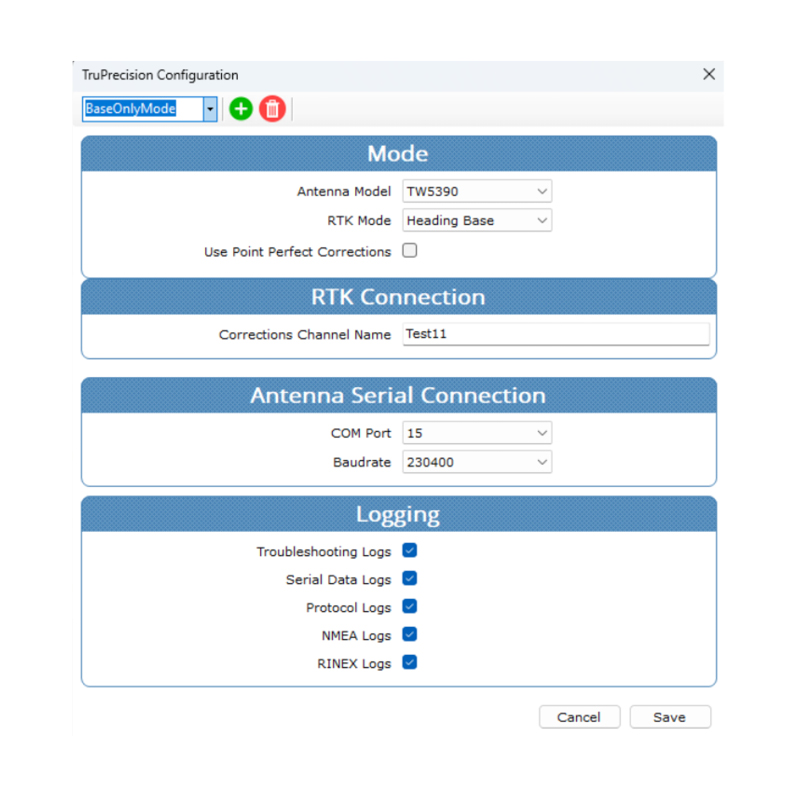
The TruPrecision SDK application is a Windows application which provides an autonomous connection to stream RTK corrections and decryption keys to the HC885XF Smart Antenna via the the USB Serial cable, which also provides a Virtual COM Port to allow customers to connect their existing applications to the Calian Tallysman Smart GNSS Antenna high precision “corrected” position data output. The position data may be either NMEA or UBX formatted messages. ROS2® Drivers are available to integration with ROS2 open framework projects.
ROS2 Drivers: https://github.com/Calian-gnss/calian-gnss-ROS2-drivers

HC885SXF Multi-Constellation Dual-Band Antenna
The patented HC885SXF helical antenna is designed for precision positioning, covering the GPS/QZSS-L1/L5, GLONASS-G1/G3, Galileo-E1/E5a/E5b, BeiDou-B1/B2b/B2a, and NavIC-L5 frequency bands, including the satellite-based augmentation system (SBAS) available in the region of operation [WAAS (North America), EGNOS (Europe), MSAS (Japan), or GAGAN (India)], as well as L-Band correction services.
Features
- Very low noise preamp (2.5 dB typ.)
- Axial ratio (≤ 0.5 dB at zenith)
- LNA gain (28 dB typ., 35 dB typ.)
- Low current (26 mA typ., 32 mA typ.)
- ESD circuit protection (15 kV)
- Invariant performance from 2.5 to 16 VDC
- IP69K, REACH, and RoHS compliant
Benefits
- Extremely light (42 g)
- Ideal for RTK and PPP surveying systems
- Excellent RH circular polarized signal reception
- Great multipath rejection
- Increased system accuracy
- Excellent signal-to-noise ratio
- Industrial temperature range
- Rugged design, ideal for harsh environments
- Extended RF Filtering
HC882SXF Multi-Constellation Dual-Band Antenna
The patented HC882SXF helical antenna is designed for precision positioning, covering the GPS/QZSS-L1/L2, GLONASS-G1/G2/G3, Galileo-E1/E5b, and BeiDou-B1/B2b frequency bands, including the satellite-based augmentation system (SBAS) available in the region of operation [WAAS (North America), EGNOS (Europe), MSAS (Japan), or GAGAN (India)], as well as L-Band correction services.
Features
- Very low noise preamp (2.5 dB typ.)
- Axial ratio (≤ 0.5 dB at zenith)
- LNA gain (28 dB typ., 35 dB typ.)
- Low current (26 mA typ., 32 mA typ.)
- ESD circuit protection (15 kV)
- Invariant performance from 2.5 to 16 VDC
- IP67, REACH, and RoHS compliant
Benefits
- Extremely light (32 g)
- Ideal for RTK and PPP surveying systems
- Excellent RH circular polarized signal reception
- Great multipath rejection
- Increased system accuracy
- Excellent signal-to-noise ratio
- Industrial temperature range
- Rugged design, ideal for harsh environments
TW5390 Smart GNSS Antenna; High Precision; IMU; L-Band; u-blox ZED-F9R + NEO-D9S
The TW5390 is a multi-band (L1/L2), multi-constellation integrated GNSS receiver/antenna with Inertial Measurement Unit (IMU) (for Untethered Dead Reckoning) and integrated L-Band receiver for PointPerfect Flex PPP-RTK corrections. The TW5390 is capable of providing sub 1 meter accuracy stand alone, sub 6 cm accuracy with PPP-RTK corrections and sub 1 cm with RTK corrections. Combined with the IMU to achieve Sensor Fusion, TW5390 supports the most demanding positioning applications in the most challenging environments such as a dense urban canyon and off-grid positioning.
Interference Resilience
The TW5390 incorporates a latest generation multi-band (L1/L2) GNSS receiver and IMU with a Tallysman Accutenna® multi-band (L1/L2/L-Band) triple band dual feed patch. The state of the art GNSS receiver supports concurrent tracking of all four major constellations (GPS, BeiDou, Galileo and GLONASS ) in multiple frequency bands. The multi-band (L1/L2) architecture is highly effective method for the removal of ionospheric error. The TW5390 employs multi-stage filtering with low noise figure LNAs, combined with the dual feed Accutenna®, which greatly improves the rejection of multi-path signal interference. The IMU Sensor Fusion further mitigates effects of severe multi-path reflections and provides continuous position availability during periods of GNSS signal obstruction offering exceptional performance to meet the most challenging precise positioning applications.
Precision Point Positioning
The TW5390 offers support for a broad range of corrections services (RTCM RTK, networked PPP-RTK or PointPerfect Flex PPP-RTK over L-Band ) allowing performance optimization according to each application’s unique requirements. The concurrent multi-band (L1/L2) access to all four satellite constellations improves the receiver’s convergence capability to deliver a quick, precise and reliable position solution which is resilient to ionospheric errors and improves resilience against interference and jamming. As an RTK rover, The TW5390 accepts RTCM RTK messaged from a base
station, Virtual Reference Station or SPARTN SSR message type via the PointPerfect Flex subscription service or commercial network RTK services such as Point One Navigation Polaris RTK and Swift Navigation Skylark Precision Positioning.
The TW5390 provides sub 6 cm positioning accuracy in conjunction with PointPerfect Flex PPP-RTK corrections and sub 1 cm accuracy with RTK. TW5390 can receive PointPerfect Flex PPP-RTK corrections over L-Band when outside of terrrestrial networking coverage.
Features
- Integrated L-Band corrections receiver for exceptional precision
- Improved noise immunity with multi-band GNSS receiver
- Improved multi-path rejection with Dual feed Accutenna™
- Multi-band GNSS receiver has high immunity to ionospheric errors
- High-reliability timing with an expansive constellation array
- High position availability in urban environment with IMU Sensor Fusion
- PPP-RTK PointPerfect Flex Augmentation
- RTK Rover configuration
- Point One Navigation Polaris RTK and Swift Navigation Skylark Cx and Nx RTK compatible
- 5V operation
- RS-422 differential signaling or RS-232
- Industrial grade IP69K enclosure
- Rugged fixed mount
- Multiple cable lengths (5m, 15m and 25m)
- Available with conical radome
HCS885XF Smart Helical GNSS Antenna; High Precision; Precise Heading; u-blox NEO-F9P
The HCS885XF is a multi-band (L1/L5), multi-constellation integrated GNSS receiver/antenna with RTK corrections and PointPerfect Flex PPP-RTK augmentation compatibility. The HCS885XF is capable of providing sub 1 meter accuracy stand-alone, sub 1 cm accuracy with RTK corrections and sub 10 cm accuracy with PPP-RTK corrections. It is based on the Tallysman HC885SXF antenna, making it light-weight and very suited for unmanned aerial vehicle (UAV) applications that require precise location and precise heading.
Interference Resilience
The HCS885XF incorporates the latest generation multi-band (L1/L5) GNSS receiver with a precision-tuned multi-band Tallysman antenna (L1/L5) that provides excellent axial ratios and operates without the requirement for a ground plane. The state of the art GNSS receiver supports concurrent tracking of all four major constellations (GPS, BeiDou, Galileo and GLONASS ) in multiple frequency bands. The concurrent multi-band (L1/L5) access to all four satellite constellations improves the receiver’s convergence capability to deliver a quick, precise and reliable position solution.
The multi-band architecture is the most effective method for the removal of ionospheric error, and the L5 band provides superior interference and multipath performance vs. L2. The HCS885XF employs Tallysman eXtended Filter (XF) technology, which mitigates near-band and out-of-band interference, such as LTE signals and their harmonics, enabling operation in the most challenging deployments.
PPP-RTK, RTK and Precise Heading
The HCS885XF offers support for corrections services (PPP-RTK – PointPerfect) or RTK base/rover corrections, allowing performance optimization according to an application’s unique requirements. HCS885XF is compatible with major public RTK services including Polaris RTK from Point One Navigation and Skylark Cx and Nx RTK from Swift Navigation. Two HCS885XFs can be configured as a Base/Rover receiver pair for moving base precise heading applications. HCS88XF mounts flush with three threaded inserts for secure attachment and provides a rubber O-ring around the outer edge for seal. Control, corrections and position output are delivered over a 6 pin JST receptacle connector inset into the base.
Features
- Superior GNSS performance with L1/L5 dual band operation
- Improved noise immunity with multi-band GNSS receiver
- Excellent RH circular polarized signal reception
- Multi-band receiver has high immunity to ionospheric errors
- Lightweight precision-tuned helical element with excellent axial ratios and Tallysman eXtended Filtering
- Extreme lightweight (38 g)
- Exceptional position performance (Stand-alone or corrected)
Benefits
- PPP-RTK: PointPerfect Flex Augmentation
- RTK Base/Rover configurations and Moving Base Heading
- Point One Navigation Polaris RTK and Swift Navigation Skylark Cx and Nx RTK compatible
- CMOS signalling with RS232 option
- Industrial-grade IP69K enclosure
- Surface Mount with O-ring seal
- 6-pin JST port for Pixhawk standard compatibility
Sprite™ TW200 Asset Tracking for MOTOTRBO™ Systems
The Sprite™ TW200 asset-tracking device lets you track your fleet using your existing Motorola MOTOTRBO™ network. Paired with Tallymatics’ Trufleet™ solution, the TW200 provides accurate event-based reporting on a range of data, such as waypoints, speeding and cumulative odometer readings.
TW5390C Smart GNSS Antenna with CLAS SDK – TP5390CSDK
Your application depends on sub 10 cm precision without network coverage. We get you there quickly, reliably and repeatedly.
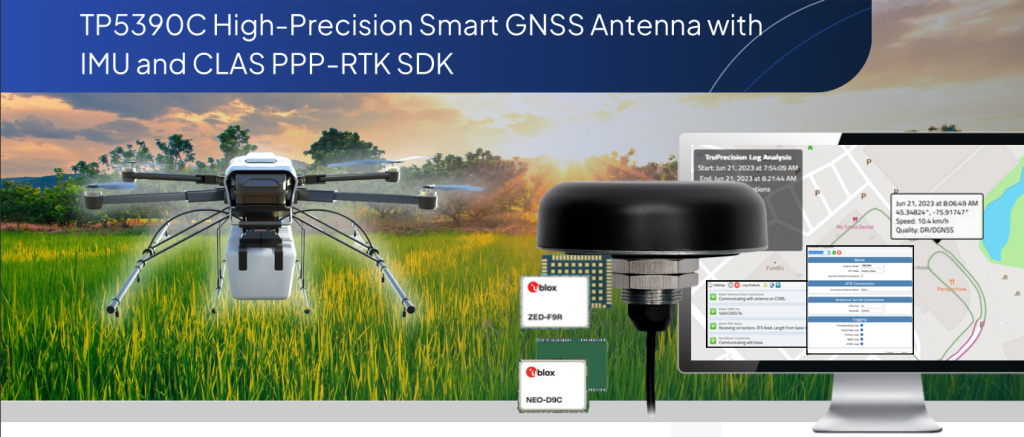
Calian’s High Precision Tallysman Smart GNSS antennas integrate advanced receivers and other processing elements with High Precision Tallysman GNSS antennas, connecting Position, Navigation and Timing resources to host systems over digital interfaces.
Calian’s High Precision Tallysman Smart GNSS antennas integrate advanced receivers and other processing elements with High Precision Tallysman GNSS antennas, connecting Position, Navigation and Timing resources to host systems over digital interfaces.
The TW5390CSDK supports the TW5390C High Precision GNSS Smart Antenna with CLAS PPP-RTK. It features:
- MQTT client for PointPerfect Flex PPP-RTK Corrrections over IP ( sub 6 cm accuracy)
- CLAS PPP-RTK corrections over L6 (sub 10 cm accuracy)
- NTRIP client for RTK Rover configurations (local or commercial network RTK such as Point One Navigation Polaris RTK and Swift Navigation Skylark Cx Precision Positioning)
- NMEA monitoring, satellite visibility and signal strength, GNSS status monitoring, Inertial Measurement Unit Sensor Fusion Status, and logging tools with visual state heat-map
- Status console to pinpoint issues between antenna, corrections and network connections
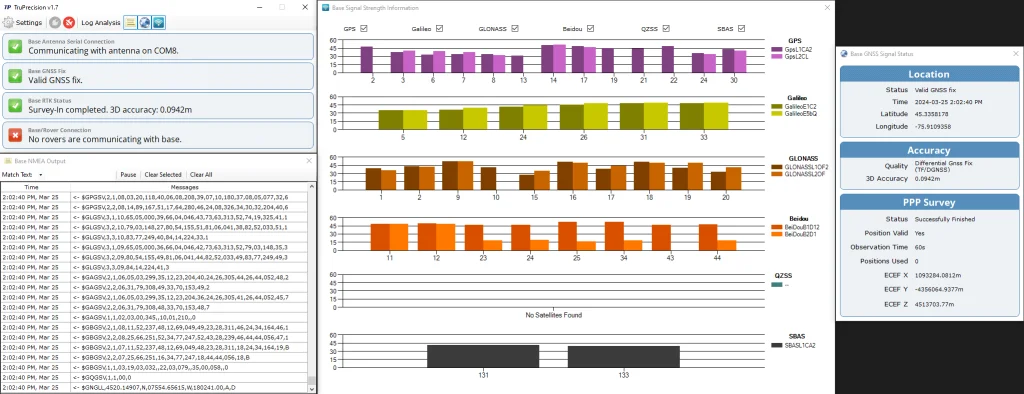
TP5390CSDK-0 includes:
- Calian 33-5390C-09-10-05-PC0 Dual Frequency Precision Smart Antenna/Receiver with L-Band receiver (RS-422)
- Calian USB Serial Bridge (33-0095-11)
- Calian TruPrecision Application for PointPerfect Flex PPP-RTK streaming over IP
- Complimentary trials
- PointPerfect Flex augmentation service (60 day free trial)
- Point One Navigation Polaris RTK (1 year free service)
- Swift Navigation Skylark Cx Precision Positioning Service (6 month free trial)
- Ordering Information: 33-TP5390CSDK-0 TruPrecision TW5390C SDK
The TruPrecison SDK application is a Windows application which provides an autonomous connection to stream PointPerfect Flex IP or N-RTK corrections and decryption keys to the TW5390C Smart Antenna via a USB Serial Bridge, which also provides a Virtual COM Port to allow customers to connect their existing applications to the Calian Smart GNSS Antenna high precision position data output. The position data may be either NMEA or UBX formatted messages..
TW5790 Smart GNSS Antenna SDK – TP5790SDK
Your application depends on sub 10 cm precision without network coverage. We get you there quickly, reliably and repeatedly.
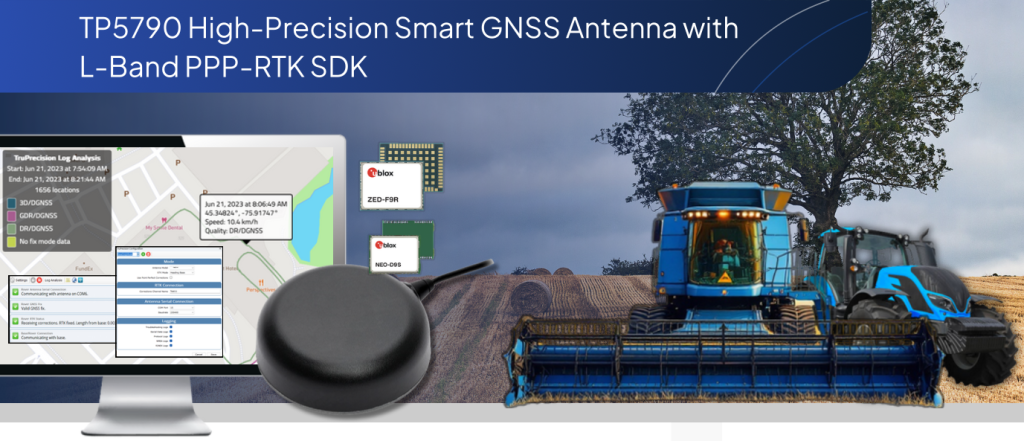
Calian’s High Precision Tallysman Smart GNSS antennas integrate advanced receivers and other processing elements with High Precision Tallysman GNSS antennas, connecting Position, Navigation and Timing resources to host systems over digital interfaces.
Calian’s High Precision Tallysman Smart GNSS antennas integrate advanced receivers and other processing elements with High Precision Tallysman GNSS antennas, connecting Position, Navigation and Timing resources to host systems over digital interfaces.
The TW5790 SDK supports the TW5790 High Precision GNSS Smart Antenna with L-Band PPP-RTK. TW5790 incorporates the u-Blox ZED-F9R GNSS receiver and NEO-D9S L-Band receiver.
It features:
- MQTT client for PointPerfect Flex PPP-RTK Corrections over L-Band or terrestrial network ( sub 6 cm accuracy)
- NTRIP client for RTK Rover Configurations; local or Point One Navigation Polaris RTK or Swift Navigation Skylark corrections (cm-level accuracy)
- NMEA monitoring, satellite visibility and signal strength, GNSS status monitoring, Inertial Measurement Unit monitoring and logging tools, with visual state heat-map
- Status console to pinpoint issues between antenna, connections and network corrections
The TruPrecision SDK application is a Windows application which provides an autonomous connection to stream PointPerfect Flex, Swift Navigation Skylark and PointOne Polaris corrections to the TW5790 Smart Antenna, which also provides a Virtual COM Port to allow customers to connect their existing applications to the Calian Tallysman Smart GNSS Antenna high precision “corrected” position data output. The position data may be either NMEA or UBX formatted messages. ROS2® Drivers are available for integration with ROS2 open framework projects.
ROS2® DRIVERS
https://github.com/Calian-gnss/calian-gnss-ROS2-drivers
TP5390SDK includes:
- 1 x Calian TW5790 Dual Frequency Precision Smart Antenna/Receiver with L-Band receiver (USB or RS-232 see ordering information)
- 1 x 23-0067-14: 10 cm ground plane
- Calian TruPrecision Application for PointPerfect IP correction streaming
- Trial subscriptions:
- PointPerfect Flex PPP-RTK (60 days free trial);
- Swift Navigation Skyark Cx (6 months free trial);
- Point One Navigation Polaris RTK (1 year free service)